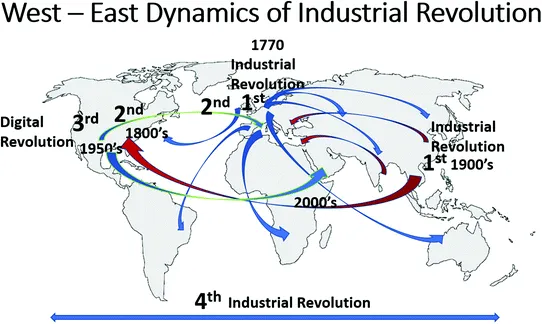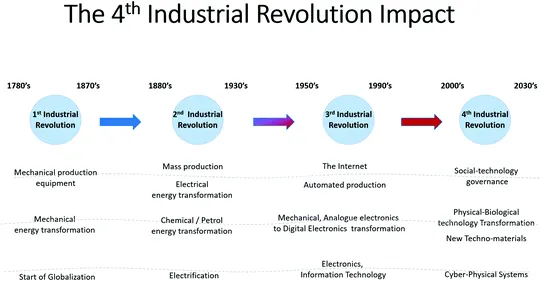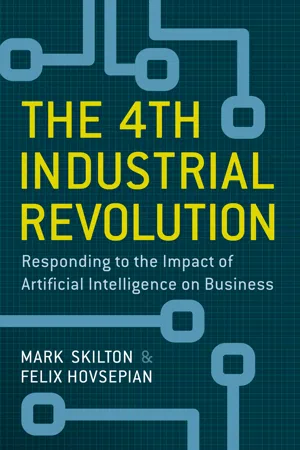Introduction
Technological advance through history predates the recent digital era and computers to previous centuries that saw radical change in political and social beliefs, as well as the spread of political power and material wealth through changing technological development in society.
Technology has traditionally been defined as the way in which scientific knowledge evolves in the production of goods and services or in achieving goals using tools and techniques to achieve outcomes. The term “technology” originates from the sixteenth century use of the Greek word tekhnologia “systematic treatment” and tekhnē “art, craft” and logia “-ology” [1]. The late renaissance period in Western Europe saw great progress in the arts and science, as well as social upheaval bridging the middle ages and modern history. Technology changed human skills-sets, we learnt how methods and processes were deployed to wield natural resources and gain advantages in competition and acquisition. The limitations of human mechanical strength and the discoveries of fire, metals, and enlightenment [2] brought the development of tools that assisted or substituted human effort.
Machines were constructed in order to provide a means for humans to operate and achieve certain tasks, or to replace the human effort in its entirety. Machinery consumed and converted energy provide by mechanical, chemical, thermal, electrical, or other means to convert work from one state to another. This evolved from personal and local use into a phenomenon that transformed society and the industrial economy.
The noun ‘industry’ stands for the production of goods or services through technology and commercial organizational advances, and ‘industrialization’ stands for the development of industries on a wide scale. The development of scientific knowledge and technology were essential for the emergence of industrialization, which in western cultures happened around the 1770s. The change from an agrarian society, based on agriculture and human social organization, to an industrial one based primarily around industry, has since become to be known as “The Industrial Revolution” [3].
The period from the late 1770s to the present day would witness a five-fold rise in global population, and a tenfold rise in GDP wealth, rates that were unheard of prior to the 18th century [4].
Most noticeable would be the shift in growth rates between the Western and Eastern economies; however, they are both converging in this information age and thereby helping to ignite the 4th Industrial Revolution, which we explore in the next section.
This chapter we shall discuss the following topics:
The four Industrial Revolutions
The transformations of energy and computation
The foundations of Industrie 4.0 and cyber-physical systems
The Four Industrial Revolutions
The industrialization of the west and east of the global is a story of social and economic development that took divergent paths driven by geography and local regional power that grew with technological. It is generally accepted that the term “Industrial Revolution” refers to the period from the 1770s to the middle of the 1870s, where technological change enabled humanity to harness mechanical and electrical forces for its own endeavors. As a result, there were many changes in manufacturing and production methods, and working practices, which created new modes of transportation and provided a new kind of infrastructure for much of society. While its genesis in the west was in Great Britain, transforming it and its empire into the workshop of the world [
5], within a century it had spread to the new world and through Asia and Pacific (see Fig.
1.1).
The term Industrial revolution first came into the lexicon of thought in 1799 [6]. By the end of nineteenth century, human society would witness world population double to 1.6 billion, a rapid rise in global GDP, and new inventions of electricity, mass production and globalization that we recognize today. The first few decades of the twentieth century saw the conflict of world war, and rapid changes in global power as west met east, the dawn of nuclear power and electronics. These transformations instigated the third revolution of information systems, and the automation of manufacturing and production. The geographical and time zone boundaries shrunk as telecommunications and new enlightenment in biology, miniaturization, transportation, media and engineering spread to consumerization and commercial acceleration through the twentieth century. The drivers for the latency with which the Asian markets, China and India in particular, arrived at industrialization were mainly due to geopolitics, proximity of a labor force and natural resources as well as colonization. In the case of India, it was a massive source of cotton and indigo that became a huge market resource for the products of the industrial revolution. The colonization of India provided huge capital funds to the British Empire, whose corporations and control of the shipping routes at that time prevented inward investment in India for its own industrial development [7]. Both India and China where affected by other factors including domestic political and military upheavals during the 1700s while Europe was going through scientific developments. China had other impacts of a large geographical country with a larger population of manual labor and relative isolation from trading marketing with other parts of the world. As recent as the 1960s, over sixty percent of the Chinese population worked in Agriculture [8]. It was not until the mid-twentieth century that industrialization at scale arrived in China to meet the needs of a rapidly growing domestic population and agricultural famine, driven by the Maoist Great Leap Forward plan in the cultural revolution of the People’s Republic of China [9].
In recent times the technologic genius of humans is perhaps most visibility illustrated by the ability to break free of the earthly boundaries as seen in the space race. From the first earth orbiting satellite Sputnik in 1957 [10] during the dawn of the space age to manned mission landing on the moon. Robotic satellites have now visited all planetary bodies in the solar system, and reached out to the outer edges of the solar system in the Oort cloud of interstellar space with the Voyager space craft launched in 1977 [11]. All this achieved in the 3rd Industrial revolution.
This revolution, which started from manufacturing, will create more capital and enable humans to accumulate more wealth to drive economic growth, is perhaps moving from technology to one based on knowledge and accelerated social change [12]. No longer is technical automation a transformation from one energy to another at a faster rate as we saw in the steam and electrical revolutions of the eighteenth and nineteenth centuries. We can look back at the twentieth century as a kind of preparation, a prelude to a new era with the digital revolution laying the ground for electronics and computing that would spread knowledge and ideas built on the earlier industrial revolutions.
The Fig.
1.2 illustrates the major trends of change that are apparent in the transitions from the 1st Industrial revolution to the present day 4th industrial revolution and decades ahead. These can be summarized to include the movement of globalization through mechanical, electrification, petrochemical combustion and the internet digitization. A second trend is the harnessing of transformation of energy for work; the third, the rise of machinery automation that would enable mass production and the creation of mechanisms that exceed human limitations and the creation of new science and insights. There is a trend here, because the changes that we see through the eras have associated with them consequences for social interaction and societal values, which must evolve with the advent of new technology.
The 1st and 2nd Industrial Revolutions
Prior to mechanization, human endeavor was driven by hand and animal stock to build, work the land and travel. Mechanical action from water, wind and fire had been used for thousands of years, from the sales on a ship to the water wheel.
The first steam engine was built by Thomas Savery in 1698 in England, called the Savery engine, [13] it was used to pump accumulated water up from coal mines but had limited application, because it used atmospheric pressure and worked against the vacuum of condensed steam to draw water. It could not be more than 30 feet above the water level and therefore had to be installed down in the mine shaft itself. It was not until 1712 that Thomas Newcomen developed the first commercial steam engine based on a piston design. It could lift ten gallons of water from a depth of 156 feet that represented 5.5 horse power [14]. The jump from vacuum pressure, to mechanical kinetic energy, to continuous rotary movement did not occur until 1781 with the advent of James Watt’s revolutionary design for his steam engine. This ten-horsepower engine enabled a wide range of manufacturing to production and agricultural machinery to be powered. This ushered in what is described as the 1st industrial revolution, because it enabled production of mechanical energy...




